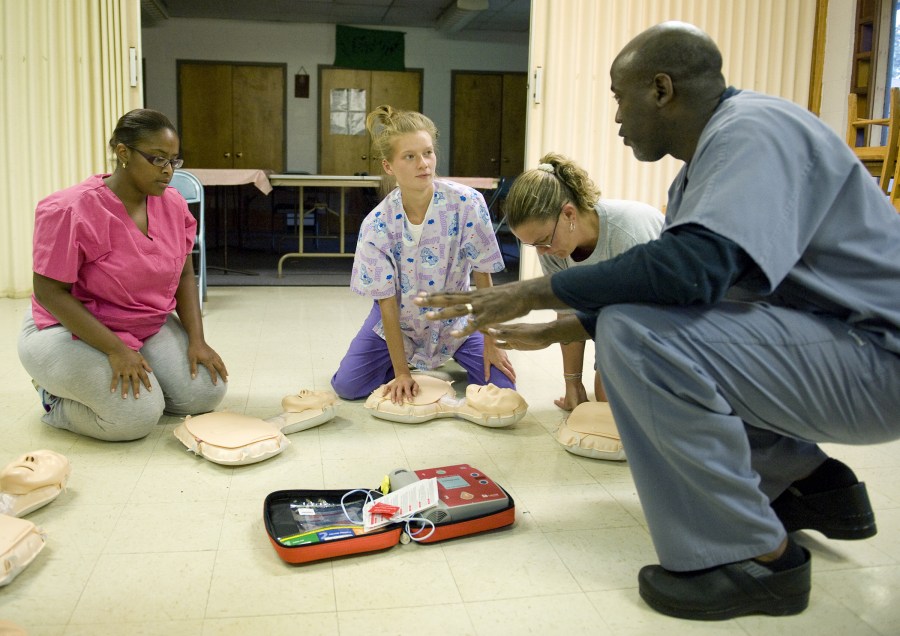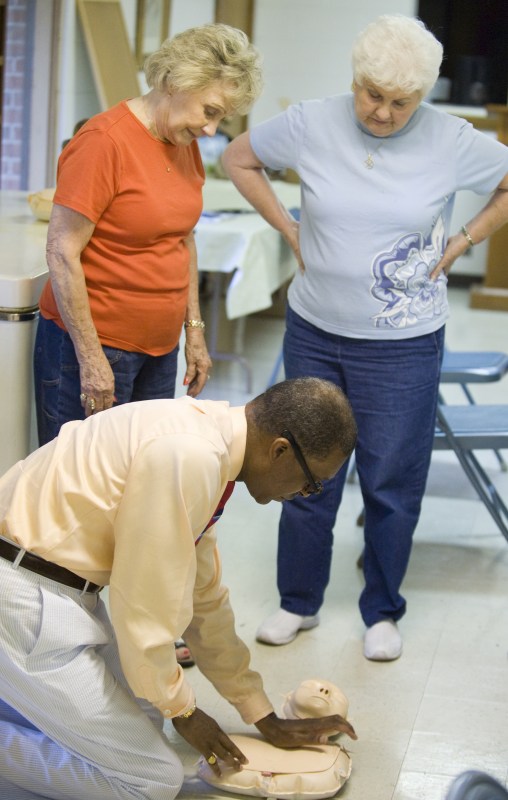
Carl Larrieu, L.P.N., right, works with, from left, Chandra Brown, Amber Buhler and Kim Milner during a recent CPR training session at St. Andrew’s United Methodist Church. (photo by Joe Howell)
New program helps educate public on proper CPR skills
Fort Campbell, Ky., soldier Dominic Evans, 32, was performing morning exercises on an obstacle course when he suffered a cardiac arrest.
Fortunately for him, his fellow soldiers knew how to administer CPR and did so for 45 minutes. Without immediate and continuous CPR, Evans likely would have died before he reached Vanderbilt University Medical Center.
John McPherson, M.D., assistant professor of Medicine, has seen his share of patients who did not survive because witnesses to the heart attack either did not know how to perform CPR or were hesitant to do it because they thought they also had to do mouth-to-mouth resuscitation, also known as rescue breathing.
“I've had patients who have had out-of-hospital cardiac arrests where people saw them collapse and didn't realize they could help them simply by pushing on their chest. Instead, they called 911 and let them lie there. The patients didn't get any CPR until paramedics arrived several minutes later. In many cases, whether that's the reason or not, those patients did not survive,” McPherson said.

Andre Churchwell, M.D., demonstrates proper chest compression techniques for Elise Cartwright, left, and Sue Gunn. (photo by Joe Howell)
According to the American Heart Association (AHA), about 75 percent to 80 percent of all sudden cardiac arrests happen at home, so being trained to perform cardiopulmonary resuscitation (CPR) can mean the difference between life and death for a loved one; approximately 94 percent of sudden cardiac arrest victims die before reaching the hospital; and on average, only 27.4 percent of out-of-hospital sudden cardiac arrest victims receive bystander CPR.
Over the last few years, the AHA has implemented an awareness campaign called Hands Only CPR, and McPherson and Andre Churchwell, M.D., associate professor of Medicine, are spearheading a program to educate the public on this lifesaving technique.
Targeted to at-risk communities, where the likelihood of cardiovascular disease is thought to be the highest, the cardiologists and a team of volunteers give CPR instruction to groups at community centers and churches.
They held the first class on Aug. 18 at St. Andrew's United Methodist Church on Clarksville Highway. Vanderbilt will also be partnering with the Junior League of Nashville to train volunteers to teach CPR.
“We know that the performance of CPR can have a profound impact on somebody's survival after cardiac arrest,” Churchwell said. “In addition, there has been an emerging body of evidence that suggests that CPR done with hands only, without rescue breathing, is just as effective, and maybe more effective, than traditional CPR that involves rescue breathing.
“It makes the procedure less intimidating, it's easier for people to remember how to do it and there is no fear of contracting a disease,” Churchwell said.
The program not only teaches proper CPR technique, but it provides information and education on how to prevent heart disease, including tips on nutrition and exercise, risk factors and how to lower them.
“I've seen patients like Mr. Evans, who did receive early CPR, end up surviving, neurologically intact. He's a great example of what can happen when chest compressions are begun immediately,” McPherson said. “As a result, he is alive and well and was able to be present at the birth of his child a few days later.”













